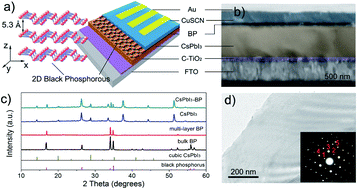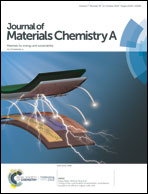Two-dimensional black phosphorous induced exciton dissociation efficiency enhancement for high-performance all-inorganic CsPbI3 perovskite photovoltaics†
Abstract
Owing to their prominent thermal stability, inorganic halide perovskites have been deemed as promising substitutes for organic–inorganic hybrid perovskites; however, their application is hindered by their mediocre efficiency. High exciton binding energies in inorganic perovskites have been considered to be one of the main obstacles, which lead to insufficient separation of bound excitons and low photocurrent output. Herein, we demonstrated an effective strategy to enhance the exciton dissociation efficiency in inorganic perovskites by incorporating layer-structure-tunable two-dimensional black phosphorous. Importantly, the energy-level configuration and work function alignment of multi-layer black phosphorous can be tuned by adjusting the number of layers, which induces built-in electric field formation and boosts interfacial charge carrier transfer. Furthermore, it is revealed that multi-layer black phosphorous can increase relative permittivity due to its efficient dielectric screening effect in a local dielectric environment, thus diminishing the exciton binding energy, enhancing the exciton dissociation efficiency and leading to a significant increase in the free carrier density of inorganic perovskites. The multi-layer black phosphorous–CsPbI3 heterostructure perovskite solar cells (PSCs) with the inorganic CuSCN hole-transport-layer (HTL) exhibit the current density of 19.3 mA cm−2 and the power conversion efficiency (PCE) of 14.17%, which is one of the highest efficiencies reported to date for PSCs with all-inorganic materials.



 Please wait while we load your content...
Please wait while we load your content...